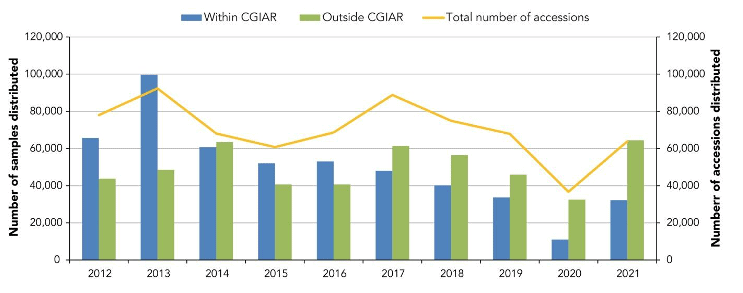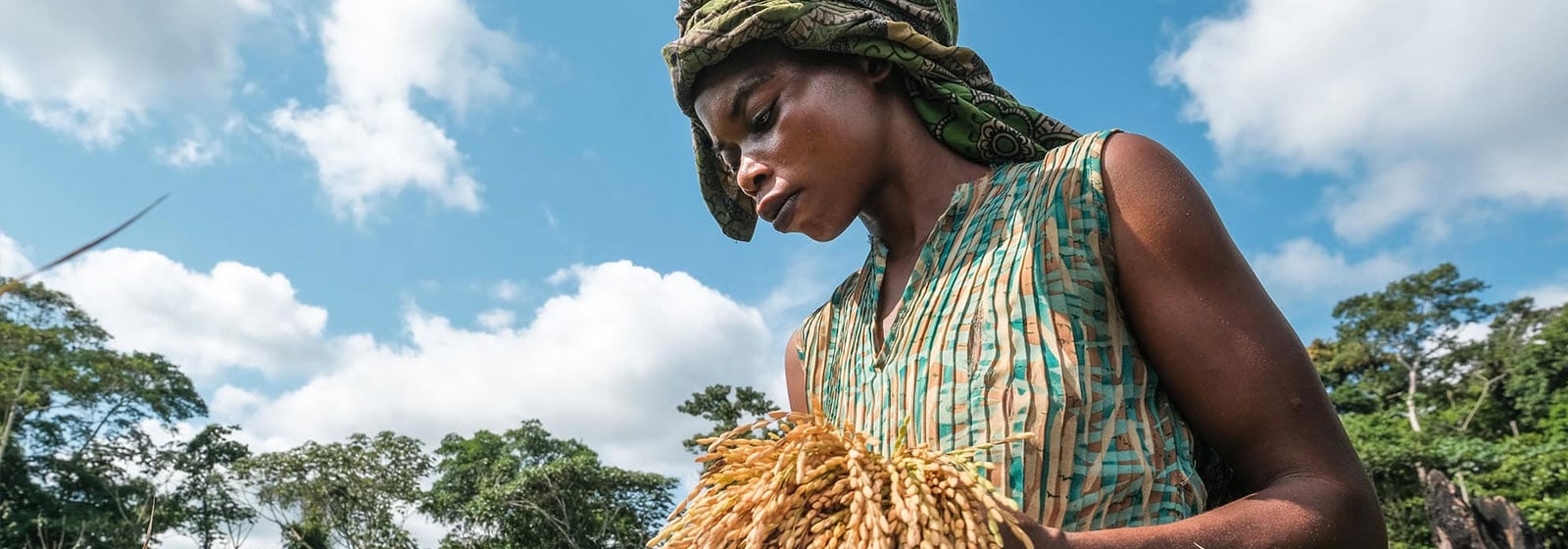Genebank Platform
The CGIAR Genebank Platform supported the activities of the CGIAR genebanks and germplasm health units (GHUs) to conserve and make available crop, forage, and tree genetic resources, contributing to the United Nations’ Sustainable Development Goals (SDGs), specifically Target 2.5.
CGIAR germplasm distribution and use
In 2021, lockdown measures associated with the COVID-19 pandemic continued to affect CGIAR genebank operations and activities. These restrictions were especially limiting for the operations of the three CGIAR genebanks in Latin America and of IRRI. Other genebanks experienced restrictions in travel, meetings, procurement, and staffing that prevented the completion of improvements and work plans.
Despite ongoing limitations, demand for germplasm and its distribution returned to familiar levels in 2021. CGIAR genebanks distributed a total of 96,590 germplasm samples (63,788 accessions) to users (Figure 1).
Figure 1. Samples and accessions distributed annually by CGIAR genebanks from 2012 to 2021

Consistently over the last five years, germplasm distribution to requesters outside CGIAR has exceeded distribution to CGIAR Programs. In 2021, 67% of germplasm distributions went outside CGIAR to recipients in 91 countries. Lower-middle income countries received the largest proportion (64%) of germplasm shipments in 2021 (Figure 2).
Figure 2. Distribution of germplasm from CGIAR genebanks in 2021 (excluding distributions to CGIAR programs)

Note: Income and regional categories based on World Bank classification.
Of the external distributions in 2021, 51% of samples were sent to universities or research institutes, 34% to national agriculture research systems, and the rest went to the commercial sector, nongovernmental organizations, farmers, and others.
Most samples (72%) were traditional cultivars or wild relatives of crops. Table 1 lists the top country recipients of germplasm from CGIAR genebanks (not including materials transferred within or between CGIAR Centers).
Table 1. Top ten countries receiving germplasm from CGIAR in 2021 (excluding distributions to CGIAR programs)
| Lower-middle income &
Low-income economies |
Upper-middle income &
High-income economies |
||||||
| Rank* | Country | Number of Accessions | Number of Samples | Country | Number of Accessions | Number of Samples | |
| 1 | India | 7,209 | 26,972 | Brazil | 2,638 | 2,693 | |
| 2 | Morocco | 4,506 | 4,506 | Italy | 2,656 | 2,659 | |
| 3 | Vietnam | 719 | 4,309 | United Kingdom | 2,133 | 2,140 | |
| 4 | Nigeria | 2,150 | 2,748 | Mexico | 1,706 | 2,052 | |
| 5 | Uganda | 2,074 | 2,074 | Germany | 1,449 | 1,449 | |
| 6 | Ethiopia | 903 | 1,114 | China | 894 | 894 | |
| 7 | Mali | 78 | 1,065 | Colombia | 652 | 753 | |
| 8 | Lao, P.D.R. | 72 | 685 | United States | 729 | 735 | |
| 9 | Ghana | 482 | 486 | Turkey | 494 | 494 | |
| 10 | Kenya | 203 | 431 | Spain | 482 | 482 | |
| Subtotal | 18,396 | 44,390 | 13,833 | 14,351 | |||
| (% from total) | 92% | 96% | 79% | 79% | |||
| Others | 1,658 | 1,904 | 3,718 | 3,815 | |||
| (% from total) | 8% | 4% | 21% | 21% | |||
| Total | 20,054 | 46,294 | 17,551 | 18,166 | |||
Notes: *Rank by number of samples. Income category based on World Bank classification.
In 2021, 67% of germplasm distributions went outside CGIAR to recipients in 91 countries. Lower-middle income countries received the largest proportion (64%) of germplasm shipments in 2021.
Progress on germplasm availability and safety duplication
By the end of 2021, CGIAR genebanks were managing a total collection of 739,653 crop, forage, and tree accessions, including 26,329 in vitro accessions and 33,889 accessions held as trees or plants in the screenhouse or field. Approximately 83% of the total collection is acceptably viable, free of quarantinable diseases, with adequate stock, and legally available for international distribution.
Of the seed accessions, 71% is secured in safety duplication at two levels and 88% is duplicated at the Svalbard Global Seed Vault. Of clonal crop collections, 70% are safety duplicated in the form of cryopreserved or in vitro cultures.
Availability rates
Despite the effect of COVID-19 lockdowns on operations, the numbers of available accessions increased in all genebanks in 2021. Five out of 10 seed collections have now reached the 90% availability target.
In 2021, all genebanks made progress toward performance targets, although there were setbacks. AfricaRice, ICRISAT, and CIP potato collections are on course to reach performance targets in the near future. Although clonal crops were highly vulnerable to the effects of COVID-19 restrictions on subculturing and safety duplication, these collections are now mostly stabilized.
By the end of 2021, at least 18,800 accessions were archived and 37,000 designated for partial curation as a result of recently published guidance on improving accession management. In response to recommendations from technical reviews, several genebank managers substantially reduced surplus seed stocks, freeing up space and allowing resources and staff to focus solely on actively curated stock. Further accessions and seed lots are expected to be rationalized, and the total size of the CGIAR collection may continue to decrease as a result.
By the end of 2021, CGIAR genebanks were managing a total collection of 739,653 crop, forage, and tree accessions, including 26,329 in vitro accessions and 33,889 accessions held as trees or plants in the screenhouse or field.
Germplasm Health Units (GHUs)
In 2021, the Germplasm Health Units (GHUs) health-tested 213,164 samples for more than 100 different seed-borne pests and pathogens. Slightly more than half of these samples were for conservation in genebanks.
GHUs facilitated around 1,600 germplasm exchanges with 126 countries. Nearly 8% of imported or exported samples were removed because of infection with pests or diseases.
Technical reviews
Together, genebanks and GHUs continued to develop quality management systems, documenting 347 Standard Operating Procedures (SOPs). The team audited 67% (118) of genebank SOPs and verified them through external technical reviews.
In 2021, Recommendation Action Plans (RAPS) were launched in each genebank. The RAPS were based on the recommendations of technical reviews conducted between 2018 and 2020 and aimed to bolster the resilience of genebanks against lockdown measures. They included efforts to improve data management, test dormancy breaking techniques in crop wild relatives, improve long-term conservation facilities, reduce redundancy in seed samples, and streamline viability monitoring.
Policy contributions
In 2021, the Genebank Platform continued coordinating CGIAR’s engagement in the ongoing development of the Post-2020 Global Biodiversity Framework of the Convention on Biological Diversity (CBD). The Platform also contributed to Plant Treaty meetings on the development of decision-making tools for the implementation of farmers’ rights under Article 9.
The Genebank Platform also participated on behalf of CGIAR in various meetings under the framework of the Plant Treaty, the CBD, and Commission on Genetic Resources for Food and Agriculture, many of which addressed the possible creation of new norms for benefit sharing derived from the use of digital sequence information. These discussions are likely to continue for several more years in international forums, given the differing stances of low- and high-income countries.
In 2021, the Genebank Platform supported CGIAR Centers in complying with their policy and legal obligations through a range of measures, including the development of guidelines and decision-making tools for improving accession management and enhancing operations under the frameworks of the Plant Treaty and the CBD. It also assisted some Centers in drafting public disclosures concerning limited exclusivity agreements and intellectual property protection applications, focusing on making clear statements about compliance.
By the end of 2021, at least 18,800 accessions were archived and 37,000 designated for partial curation as a result of recently published guidance on improving accession management.



